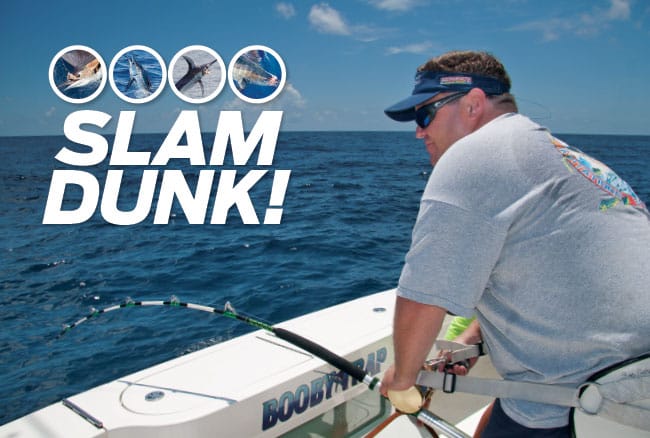
Texas Billfish Slam
As the rigged squid fell away into the azure blue of the Gulf of Mexico that warm July afternoon, Capt. Brett Holden looked over at me and grinned. “Let’s see what’s down there,” he said, his smile broadening as the bait dropped deep, out of sight.
We had just caught and released a white marlin, a sailfish and a blue marlin in a mere three-and-a-half hours of fishing time aboard Holden’s 52-foot Viking express, Booby Trap. But our mission wasn’t yet complete.
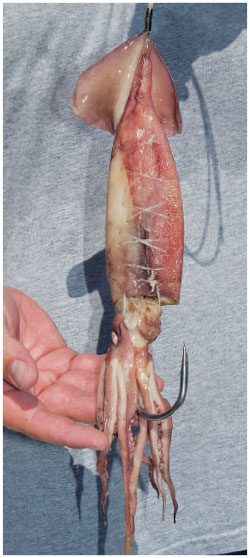
| |The Booby Trap crew has dropped plenty of rigged squid baits for swordfish over the past few years. (Courtesy boobytrapfishingteam.com)|
The bait finally reached bottom, at 1,700 feet, and Texan angler Travis Joyce cranked in the slack. Not even 30 seconds later, the 80-pound outfit bumped violently. Joyce waited like a cat and then pounced, cranking violently as the rod doubled over.
“Now!” Holden yelled to Capt. Jeff Wilson, who throttled Booby Trap forward against a solid resistance. “Tight, sucka!” screamed Holden, his trademark line, wheeling around and high-fiving it with swordfishing friend “Disco” Luis Herrera of Miami.
A half-hour later, the 125-pound swordie was leadered and carefully released, securing a coveted IGFA Super Slam for Joyce — his second while fishing with Holden and just the 21st ever registered in the IGFA record books.
That night, as you might imagine, the celebrating got a little rambunctious.
A Lifetime Achievement
In the world of billfishing, there are accomplishments, and then there are accomplishments. This ranks pretty high. After all, we’d set out with the express purpose of catching a Super Slam (four species of billfish caught by a single angler in a 24-hour period), but really, who plans to do that and actually succeeds? And in just four hours of fishing time?
We accomplished the feat as the result of several factors: an experienced crew, a healthy dose of luck and, perhaps most important, a damn good fishery. Welcome to east Texas and the offshore pelagic grounds generally referred to as the Hilltops.
Our July trip out of Surfside Marina in Freeport, Texas, spanned three days in the Gulf, where we overnighted under starlit skies and fished from 70 to 110 miles off the coast.
In addition to the slam, we released another sail and two swords, totaling seven billfish. But that wasn’t all. Our party also cashed in on 14 wahoo, averaging 20 pounds apiece, and more than a dozen big dolphin, the majority of which registered between 25 to 45 pounds.
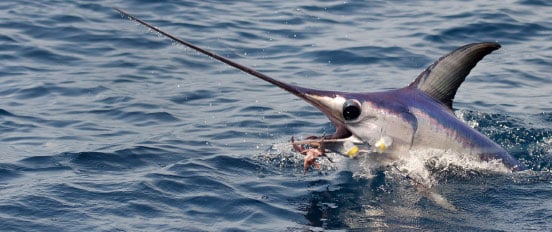
| |Last year the Booby Trap caught 172 swordies in just 15 trips off Texas. (Mike Mazur)|
To say the fishing was stellar would be an understatement. But then again, this is not so unusual ’round these parts of Texas.
“The Gulf in this region has the continental shelf, several oil rigs and deepwater mountain ranges,” says Holden, owner of a successful roofing business who has annually run 15 to 30 overnighters off the Texas coast during the past 25 years. “These areas all hold large numbers of blue marlin, white marlin, sailfish and swords. Wahoo, dorado, blackfin and yellowfin tuna also are abundant.”
Because the grounds lie far offshore, pressure isn’t excessive. In fact, we saw only one other boat during our trip. The dolphin and wahoo were an added bonus. We simply stumbled upon them on the troll along rips, and they provided great fun between our primary objective — cashing in on the area’s rich billfish bounty.
Many Species, Many Spots
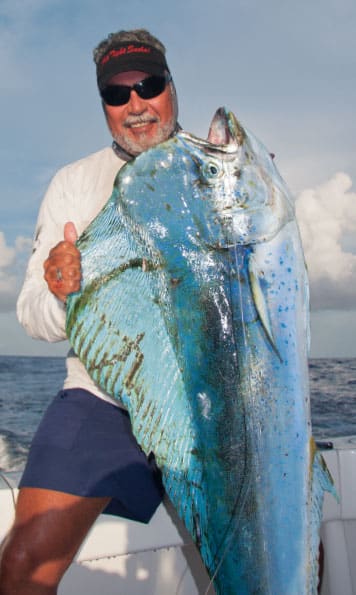
| |Forty-five- to 50-pound bull dolphin are not unusual off the Texas coast, as “Disco” Luis Herrera attests.|
Texas is a huge state sporting a lengthy coastline and, as you might expect, the offshore fisheries vary greatly from one end to the other.
“Different parts of the coastal bend offer closer fishing for billfish,” says Holden. “For example, sails and whites are pretty abundant down south around Port Aransas, with a much closer run than Freeport. The Matagorda area offers a 50-mile run to sails, whites and blue marlin action, but it’s hit or miss in that range. I’ve chosen to fish out of Freeport due to the selection of areas and structure to fish. There are several areas to target all the various billfish — the swords, blues, whites and sails.
No question, this area is extremely diverse, both in terms of fish-holding structure and the species it attracts. In fact, our slam occurred within a mere 10-mile radius. We nabbed the white first at 11 a.m. on June 23 in a deep trench known as the East Pocket, and then moved northeast to an oil platform called Little Sister, which produced the sail at 11:35 a.m. We then ran due west to another platform called West Cerveza, where we caught a 125-pound blue marlin at 2 p.m. From there, it was a direct shot southeast to a productive swordfish zone dubbed by locals as the Booby Trap Dome (yes, it’s named after these guys). The super-slam record-setting swordie was released at 3 p.m.
“Texas definitely has a great fishery for the Super Slam,” says Holden. “I would say mid-June through the end of August is the best time to target that feat. Many boats here have caught a Grand Slam (three species in one day), but they’ve never been consistent on the swords.”
Not so for Holden’s Booby Trap — but more on that later.
April through June constitutes the beginning of billfish season, with excellent currents, rips and blue-water lines forming along the continental shelf. As the water warms, the blues, whites and sails begin stacking in greater numbers along the shelf.
Because of the long runs, weather windows pretty much dictate everything here. The winter and spring windows are generally short lived, but summertime can offer lengthy stretches of nice, flat Gulf water, and comfortable fishing and overnighting.
It’s an added bonus that just happens to be during the time the fishery is on fire.
Getting It Done
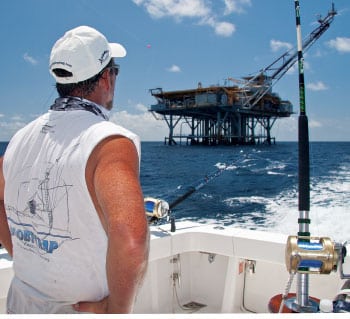
| |Capt. Jeff Wilson watches the spread closely, as Booby Trap circles West Cerveza, an excellent blue marlin oil platform. (Mike Mazur)|
We caught our marlin and sails on the troll. It was a relatively simple affair. We ran a mix of 30s and 50s in the outriggers, and a pair of 80s on the port and starboard flats. The outrigger lines were rigged with ballyhoo, both naked and outfitted with Ilanders. On the 80s, we pulled Makaira marlin lures.
“I like fishing a mixed spread when the whites, sails and blues are all in one area,” Holden says. “Why not target them all?”
The sails and whites first start showing up south of Holden’s waters and then migrate into the Hilltops as summer kicks in. It’s there that they’re joined by the blues.
Holden loves to live-bait blue marlin around the oil platforms with small tunas, rainbow runners and blue runners. But he cautions that this entire area sees radically changing water conditions from day to day because of the Gulf’s Loop Current. It makes fish move quickly and requires that anglers be prepared to fish for any of the various species on any given day with any given technique as well as monitor ocean conditions closely. Holden is a huge proponent of Hilton’s Realtime-Navigator service, and he constantly monitors its charts and maps.
“That’s the great thing about this fishery,” he says. “It’s changing every day, and the more versatile a fisherman you are, the more fun you can have.”
While Texas has never produced a grander blue marlin, Holden says he’s seen two that were in the ballpark. He’s released several in the 600- to 700-pound range and says it’s a great fishery for 400- to 600-pounders, though the average is more like 125 to 350 pounds.
It can also produce numbers. His best day netted seven blues — and he lost three others that same day.
But for as good as the marlin fishing can be, Holden has taken a break from them in the past year. Instead, he’s focused exclusively on broadbill.
Dropping into the Deep
In 18 trips during 2011, Booby Trap caught 86 swords and 20 blues, whites and sails. But in 2012, putting marlin on the side burner (except for our quest in July, which made the feat all the more impressive), day-dropping for swords has been the name of Holden’s game during just about each of his 15 trips.
The results? One hundred and seventy-two swordfish, most of which were released and many of which would have eclipsed the current Texas state record of 341 pounds.
During one particular trip, Booby Trap caught and released 21 swords in 24 hours. Another trip netted 21 swords in 31 hours. Still another produced 12 swords, 10 of which were estimated at between 200 to 450 pounds. He’s also lost some monsters, including a fish he figured at well over 1,000 pounds, which fought for 23 hours before getting off.
No question, Holden has single-handedly put this fishery on the map and pushed existing day-drop techniques — born first in Venezuela, then in Florida — to new heights, even establishing the Texas Swordfish Seminar that is proving to be very popular.
As with the marlins’ reactions to the quickly changing Loop Current, Holden has figured out how the swords react to and move in current at depth. He also has mastered the use of his Furuno NavNet 3-D electronic displays when analyzing the currents around swordfish structure.
One more thing: His team has become adept at producing daytime doubles when conditions are right. “We caught 12 double-headers on daytime swords this year,” Holden says.
Sure enough, one of those doubles occurred during our adventure this past July. As soon as the Super Slam was accomplished with our swordfish release, the boys dropped down again — but this time using their dual-rod technique.
In no time flat, two swordfish were hooked, brought to the boat and released. Just like that.
It was the icing on the cake of a day I won’t soon forget — and a fishery that’s impossible to forget.
Overnighting Is a Huge Commitment
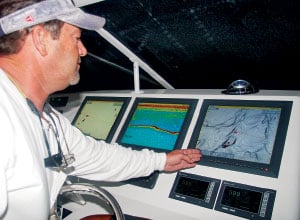
| |(Mike Mazur)|
If you’re planning to overnight in the Hilltops off Texas, or anywhere for that matter, you’ve got to prepare for the worst.
It starts with watching the weather like a hawk.
“Back in the ’80s, it was a haul to make the trip to the 100-fathom curve, and there was major risk,” says Holden. “There is still risk in every trip with the weather, but with today’s forecasting and the new, faster boats, you have a better estimate of what you’re up against.”
Even during our trip in July, which occurred in weather about as good as you could hope for, we still saw plenty of thunderstorms and rapidly changing conditions at times.
As such, it’s crucial to have weather-forecasting services aboard your boat. Also, before you leave the dock, make absolutely certain your boat is operating in tip-top shape, and double-check that you have visual distress signals, life jackets, sound-producing devices, fire extinguishers and personal locator beacons.
Fuel burn is also crucially important on long-range trips, and an operator must intimately understand his vessel’s range and capabilities.
Then there’s the fish — if you get into them like we did, you’d better be prepared. We brought 65 bags of ice. And, of course, you’ll need plenty of food and drink for three days.
“You can never be overprepared,” says Holden.








